The Oriental Scops Owl (Otus sunia) is a captivating avian species that enchants bird enthusiasts and researchers alike with its nocturnal mystique and distinct features.
Belonging to the family Strigidae, this small to medium-sized owl inhabits a diverse range of wooded environments across Asia, from India and China to Southeast Asia and the Middle East.
Renowned for its adaptive camouflage, the Oriental Scops Owl showcases intricate plumage patterns that aid in seamless integration with its surroundings.
Its large, striking yellow eyes and well-defined facial disc contribute to its charismatic appearance. A master of nocturnal hunting, this owl employs a sit-and-wait strategy, preying on insects, small mammals, and birds.
Beyond its captivating physical traits, the Oriental Scops Owl plays a vital role in maintaining ecological balance, making it a subject of conservation concern amidst habitat threats.
Understanding the intricacies of its behavior and ecology unveils the remarkable life of this enigmatic nocturnal bird. Stay sharp.
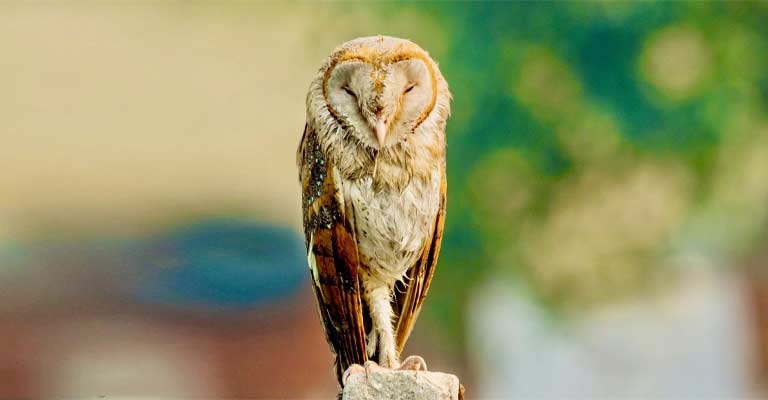
Physical Characteristics of Oriental Scops Owl
The Oriental Scops Owl (Otus sunia) is a small owl species found in various parts of Asia, known for its distinct physical characteristics that aid in its identification.
Here are some of the key points to help identify this specific bird:
Size and Shape
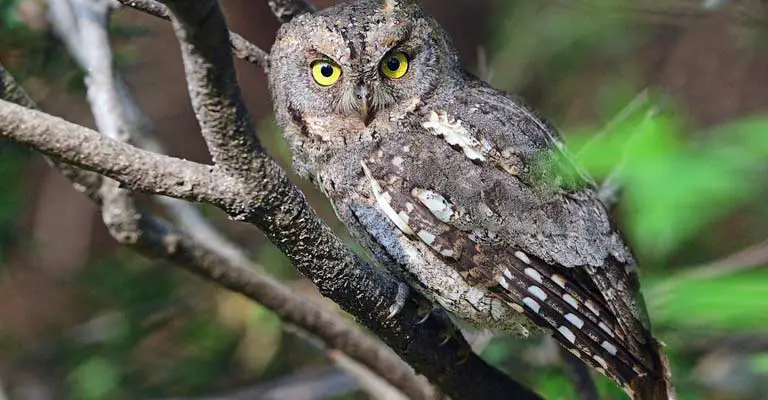
The Oriental Scops Owl is relatively small, measuring about 20-25 centimeters in length. It has a compact and stocky build with a rounded head and no ear tufts.
The overall appearance is charmingly compact, making it easily distinguishable from other owl species in its range.
Coloration
The plumage of the Oriental Scops Owl exhibits a remarkable variation in color, providing effective camouflage in its natural habitat.
The upper parts are typically brown or rufous, often with intricate patterns and markings that aid in blending with the surrounding tree bark.
The underparts are lighter with streaks and bars, contributing to its cryptic appearance.
Facial Features
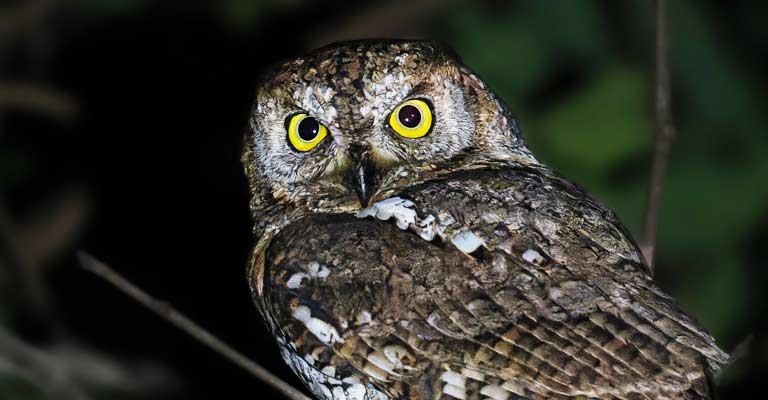
The facial disc of the Oriental Scops Owl is well-defined and presents a characteristic pale border. Its large, striking yellow eyes stand out against the darker facial plumage.
This distinctive facial pattern contributes significantly to the owl’s unique appearance and aids in identifying it in the wild.
Voice
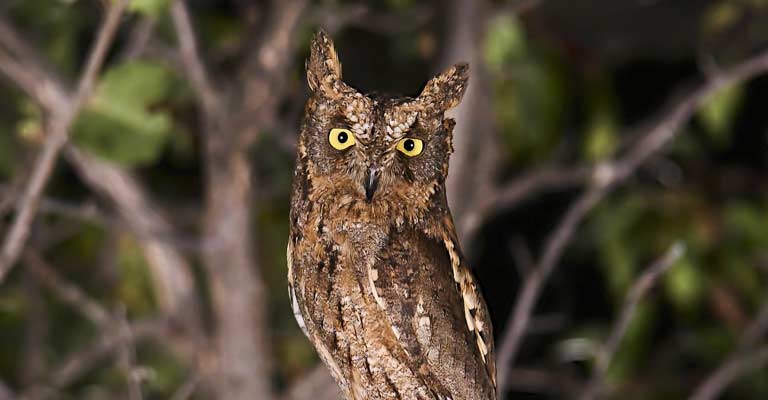
Auditory cues play a crucial role in identifying the Oriental Scops Owl. Its vocalizations consist of a series of rhythmic hoots or whistles, often resembling a repetitive “po-po-po” sound.
These calls are more commonly heard during the breeding season and serve as a key identification feature for bird enthusiasts.
Habitat
The Oriental Scops Owl is primarily found in a variety of wooded habitats, including deciduous and evergreen forests, as well as mixed woodlands.
It tends to prefer areas with dense vegetation, providing ample cover for roosting and nesting.
Nocturnal Behavior
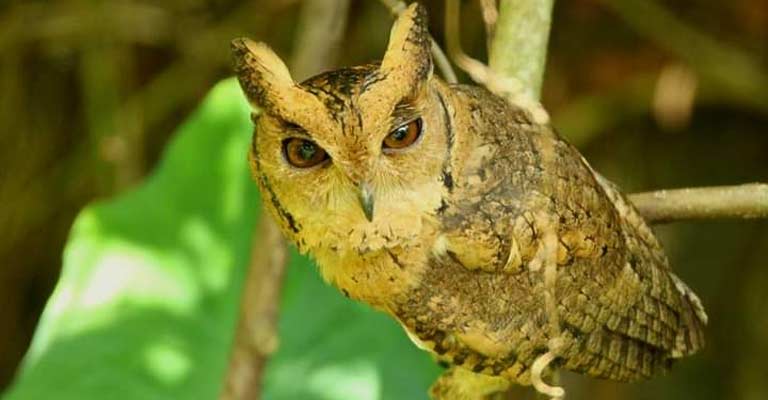
Like many owl species, the Oriental Scops Owl is primarily nocturnal. It hunts during the night, using its keen vision and hearing to locate prey such as insects, small mammals, and birds.
Observing its nocturnal behavior can be a key factor in confirming its identity.
Range and Distribution
The Oriental Scops Owl has a broad distribution across Asia, including countries such as India, China, Southeast Asia, and parts of the Middle East.
Understanding its geographical range is crucial when attempting to identify this owl in the wild.
Flight Pattern
When in flight, the Oriental Scops Owl displays distinctive wing beats and a characteristic buoyant flight.
Its short wings and rapid, direct flight are indicative features that, when combined with other identifying factors, contribute to an identification.
The Oriental Scops Owl’s unique combination of size, coloration, facial features, vocalizations, distribution, and flight pattern collectively make it an intriguing and identifiable bird species for those keen on birdwatching and ornithology.
Taxonomical Details of Oriental Scops Owl
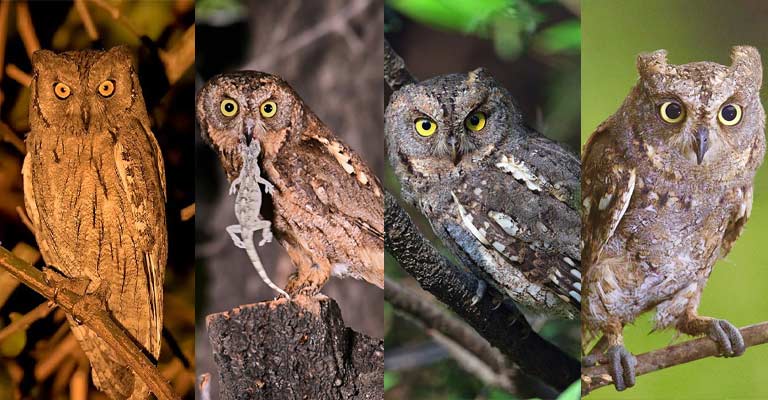
Here is a table summarizing the taxonomy details of the Oriental Scops Owl:
| Taxonomic Level | Classification |
| Domain | Eukaryota |
| Kingdom | Animalia |
| Phylum | Chordata |
| Class | Aves |
| Order | Strigiformes |
| Family | Strigidae |
| Genus | Otus |
| Species | O. sunia |
The Oriental Scops Owl (Otus sunia) belongs to the family Strigidae, commonly known as typical owls. As a member of the Otus genus, it shares taxonomic classification with several other owl species.
These birds are characterized by their nocturnal habits, distinctive facial discs, sharp talons, and exceptional adaptations for hunting in low light conditions.
Within the Otus genus, the Oriental Scops Owl is part of a diverse group of small to medium-sized owls found across various regions of Asia and Europe.
Taxonomically, these owls contribute to the rich biodiversity of avian species, each adapted to specific ecological niches within their respective habitats.
Oriental Scops Owl’s Common Food
The Oriental Scops Owl (Otus sunia) is a carnivorous bird with a diverse diet that primarily consists of small prey items. Here’s a brief overview of its common food sources:
- Insects: The Oriental Scops Owl is known for its insectivorous diet, and a significant portion of its food intake comprises various insects. Beetles, moths, grasshoppers, crickets, and other arthropods are commonly hunted by this owl.
- Small Mammals: While insects form the bulk of their diet, Oriental Scops Owls also prey on small mammals. This may include rodents like mice and shrews, providing a protein-rich food source that supplements their nutritional needs.
- Birds: Occasionally, Oriental Scops Owls may target small birds, seizing the opportunity when they are within reach. Young birds or smaller species are more likely to be preyed upon by these owls.
- Amphibians and Reptiles: Amphibians and reptiles, such as frogs, lizards, and small snakes, also make it onto the menu of the Oriental Scops Owl. Their ability to adapt to various prey types contributes to their success as opportunistic hunters.
- Worms and Caterpillars: In addition to larger insects, Oriental Scops Owls may consume worms and caterpillars. These softer invertebrates offer a different texture and nutritional profile compared to harder-bodied insects.
- Crustaceans: In certain habitats, where aquatic environments are accessible, Oriental Scops Owls may feed on small crustaceans, including crayfish and crabs.
- Spiders: These owls are known to include spiders in their diet. The abundance of arachnids in their woodland habitats makes them an easily accessible and energy-rich food source.
- Occasional Frogs and Fish: In some cases, Oriental Scops Owls may catch frogs or small fish if they are present in their hunting grounds. This behavior is less common but highlights their adaptability to various food sources.
The versatility in the Oriental Scops Owl’s diet allows it to thrive in a range of environments, demonstrating its ability to exploit different prey items based on availability and seasonal variations in the ecosystem.
Oriental Scops Owl Life History
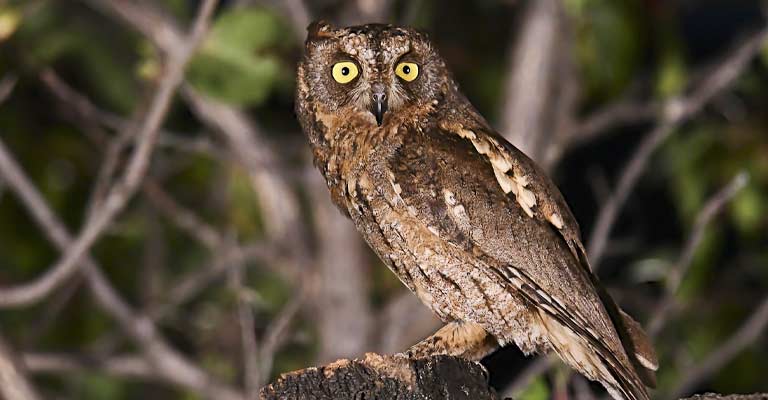
The Oriental Scops Owl (Otus sunia) is a captivating nocturnal bird species with a rich and diverse life history.
From its habitat preferences to breeding habits, nesting behavior, and conservation status, various aspects contribute to understanding the life of this remarkable owl.
Habitat
Oriental Scops Owls exhibit adaptability in their habitat selection, commonly inhabiting a range of wooded environments.
Deciduous and evergreen forests, mixed woodlands, and areas with dense vegetation become their preferred dwellings, providing optimal cover for roosting and hunting.
This owl species is often associated with regions ranging from India and China to Southeast Asia and parts of the Middle East.
Range Map
The Oriental Scops Owl boasts a wide distribution across its range, represented by a distribution map encompassing diverse ecosystems.
Their presence is documented in countries like India, China, Bangladesh, Myanmar, Thailand, and Vietnam.
Understanding their range map aids researchers and conservationists in monitoring populations and implementing effective conservation strategies.
Breeding
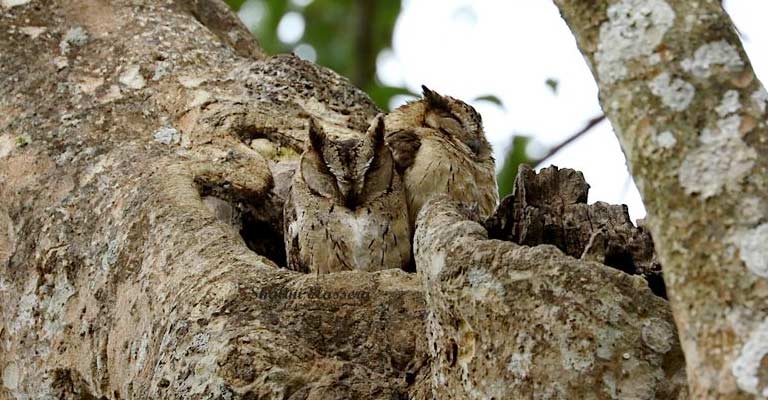
Breeding in Oriental Scops Owls typically occurs during the spring and early summer months.
Males engage in courtship displays, involving hooting and other vocalizations, to attract potential mates. Once paired, the female selects a suitable nesting site and lays a clutch of eggs.
The incubation period is managed primarily by the female, showcasing a typical raptor breeding pattern.
Nesting
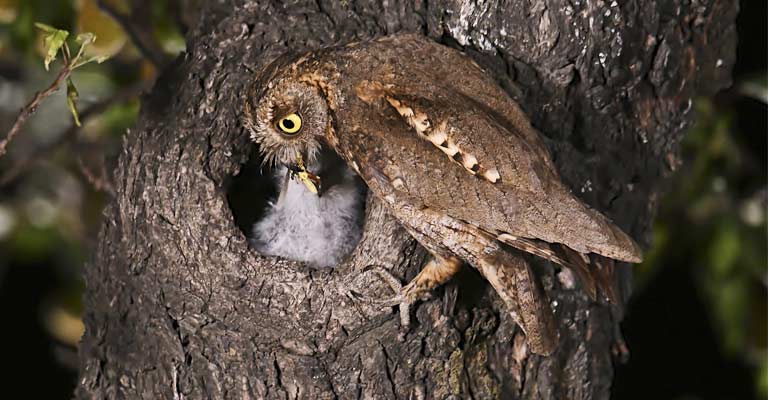
Nests are often constructed in tree hollows, abandoned nests of other birds, or dense foliage.
The female lays a variable number of eggs, usually ranging from two to four, depending on factors such as food availability and environmental conditions.
The nesting period is a critical phase, requiring both parents’ involvement in feeding and protecting the chicks until they fledge.
Here’s a table outlining the nesting details of the Oriental Scops Owl (Otus sunia):
| Nesting Details | Oriental Scops Owl |
| Clutch Size | 2 to 4 eggs |
| Number of Broods | Usually 1 per breeding season |
| Egg Length | Approximately 32 to 39 mm |
| Egg Width | Approximately 28 to 35 mm |
| Incubation Period | Around 25 to 28 days |
| Nestling Period | Approximately 20 to 30 days |
| Egg Description | White and slightly glossy |
| Nest Type | Often in tree hollows or abandoned nests |
| Nest Location | Typically in dense foliage or tree hollows |
| Nest Building | Limited nest-building, uses existing sites |
| Parental Involvement | Both parents involved in incubation and feeding |
| Fledgling Independence | Fledglings become independent after a few weeks |
| Special Nesting Behaviors | Female incubates while the male provides food |
These details provide a comprehensive overview of the nesting habits of the Oriental Scops Owl, highlighting aspects such as clutch size, incubation and nestling periods, egg dimensions, and other relevant nesting behaviors.
Diseases
Like many bird species, Oriental Scops Owls can be susceptible to various diseases, including avian influenza and respiratory infections. Monitoring their health is crucial for ensuring the stability of populations.
Treatment
Veterinary intervention may be necessary if individuals show signs of illness.
Proper medical care, rehabilitation, and quarantine measures can be implemented to prevent the spread of diseases within the population.
Conservation efforts often include monitoring the health of these birds in the wild and addressing emerging threats.
Conservation
The Oriental Scops Owl faces threats related to habitat loss, deforestation, and potential pesticide exposure.
Conservation initiatives focus on preserving their natural habitats, creating protected areas, and raising awareness about the importance of these owls in maintaining ecological balance.
Collaborative efforts between local communities, governments, and conservation organizations are crucial for safeguarding this species and ensuring its continued presence in the wild.
The life history of the Oriental Scops Owl is a fascinating narrative of adaptation, reproduction, and survival, underscored by the ongoing need for conservation efforts to secure the future of this enchanting nocturnal bird.
Behavioral Habits of Oriental Scops Owl
The Oriental Scops Owl (Otus sunia) exhibits a range of behavioral habits that contribute to its survival, reproduction, and overall adaptation to its environment.
Here are some key behavioral traits of the Oriental Scops Owl:
Nocturnal Activity
As a primarily nocturnal bird, the Oriental Scops Owl is most active during the night.
Its behaviors, such as hunting, vocalizations, and territorial displays, are mainly concentrated in the darkness, allowing it to exploit the cover of darkness for hunting and avoiding diurnal predators.
Territoriality
Oriental Scops Owls are known to be territorial, with each pair defending a specific area that includes their nesting site and hunting grounds.
They often communicate their presence and boundaries through hooting and other vocalizations, establishing a clear territory.
Camouflage and Roosting
During the day, these owls rely on camouflage to remain inconspicuous and avoid predators.
They often choose roosting sites that provide good cover, such as dense foliage, tree hollows, or other well-hidden locations where their cryptic plumage helps them blend seamlessly with their surroundings.
Courtship Displays
During the breeding season, Oriental Scops Owls engage in courtship displays to attract mates.
These displays may involve vocalizations, puffing up of feathers, and other visual cues. Successful courtship leads to pair bonding and the initiation of the breeding process.
Hunting Techniques
Oriental scop owls employ a sit-and-wait hunting strategy. Perched on a branch or other vantage point, they patiently wait for prey to come within striking distance.
Once prey is detected, they use their sharp talons and beaks to capture and consume it.
Vocalizations
Vocalizations play a crucial role in the communication and behavior of Oriental Scops Owls.
Their calls include a series of rhythmic hoots or whistles, often used for territorial marking, mate attraction, and general communication with other owls in the vicinity.
Parental Care
Both male and female Oriental Scops Owls contribute to parental care. The female is primarily responsible for incubating the eggs, while the male provides food during this period.
After hatching, both parents participate in feeding and protecting the nestlings until they fledge.
Seasonal Migration
Some populations of Oriental Scops Owls are known to undertake seasonal migrations in response to changes in food availability or environmental conditions.
This behavior allows them to optimize their chances of survival and reproduction.
Understanding these behavioral habits provides valuable insights into the life and ecology of the Oriental Scops Owl, contributing to effective conservation and management strategies for this species in various ecosystems.
Wrapping Up
The Oriental Scops Owl, with its intriguing nesting habits, adaptive behaviors, and nocturnal lifestyle, stands as a fascinating subject in the avian world.
From its territorial displays and courtship rituals to the meticulous care invested in parenting, the life history of this owl species reflects a delicate balance between survival instincts and the complexities of its natural environment.
As conservation efforts continue to play a pivotal role in preserving their habitats and ensuring their well-being, the Oriental Scops Owl remains an enigmatic and captivating species, worthy of admiration and protection. Thank you so much.